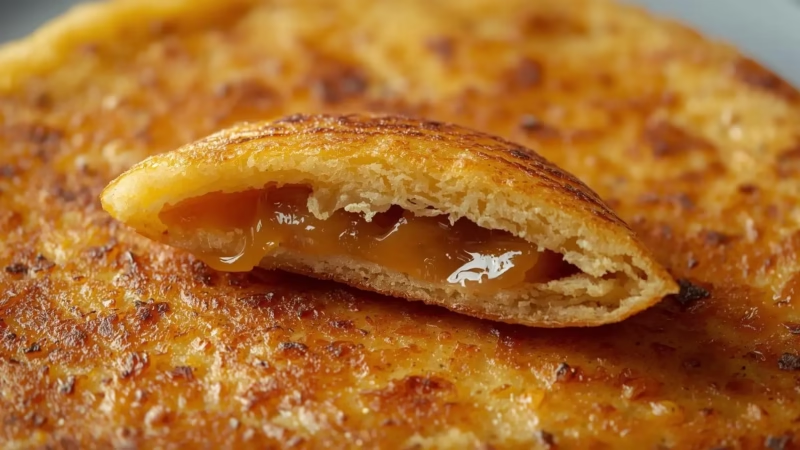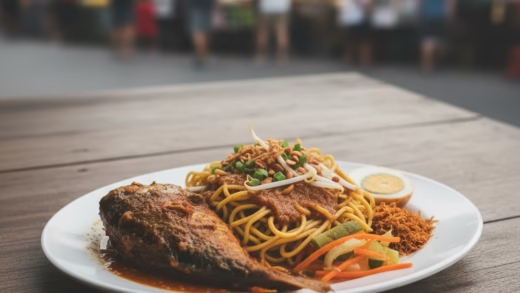Apam Balik

What it is Apam Balik?
Apam balik (also known by various other names like ban jian kueh, martabak manis, terang bulan, peanut pancake) is a sweet pancake or turnover-style snack originating from Fujian, China. It’s now common in many Southeast Asian countries, especially Brunei, Indonesia, Malaysia, and Singapore.
Names & Regions – Apam Balik
Apam Balik has many alternate names depending on language or region in Asia:
| Country | Local Name(s) | Notes |
|---|---|---|
| Malaysia | Apam Balik, Ban Jian Kuih, Min Jiang Kueh | Popular street food, crispy or fluffy versions available. |
| Singapore | Ban Jian Kuih, Min Jiang Kueh | Usually softer and thicker, filled with peanut, sugar, corn, or kaya. |
| Indonesia | Martabak Manis, Terang Bulan, Kue Bandung | Often thicker, richer, with cheese, chocolate, condensed milk toppings. |
| China (Mandarin) | 滿煎糕 (Mǎn Jiān Gāo) | Traditional Chinese pancake; also influences versions in SEA. |
| Thailand | Khanom Bueang Yuan (variant) | Thai adaptation, crispy shell with sweet/savory fillings. |
| Philippines | Bibingka Apam (variant), sometimes “Martabak” | Adapted into local pancake traditions. |
| Brunei | Kuih Malaya, Apam Balik | Similar to Malaysian version, both crispy and thick types. |
| Vietnam | Bánh xèo (different style, but comparable) | Rice flour pancake, often savory, but linked conceptually. |
Apam balik is a crispy and fluffy Asian pancake turnover filled with roasted peanuts, sugar, creamy sweet corn, butter and folded into half.
Origin & History
Apam Balik is a traditional Southeast Asian pancake that originated in Malaysia, though it is also popular in Indonesia, Singapore, and Brunei. Its roots trace back to the 15th century during the Malacca Sultanate when Chinese traders influenced local cuisine. The dish became widely known during the visit of Chinese admiral Zheng He, who introduced a form of pancake that was later localized with peanuts and corn.
- The pancake is believed to have originated in the Fujian region of China, later spreading into Southeast Asia via Chinese immigrants.
- There is a popularly told but not fully verified story attributing its creation to General Zuo Zongtang during the Qing dynasty (mid-19th century) in Fujian, who supposedly introduced a version of pancake using locally available sugar cane and peanuts as filling for his soldiers.
Category
It belongs to the category of street food, snacks, and desserts, often sold at hawker stalls and night markets.
Appearance
Apam Balik is a golden-brown, folded pancake with a crispy or fluffy texture depending on its thickness. It resembles a half-moon or turnover after being folded with fillings.
Ingredients
- Batter: Wheat flour, rice flour (optional), baking soda, sugar, water, and eggs.
- Fillings: Crushed roasted peanuts, sweet corn kernels, sugar, butter or margarine.
- Optional: Chocolate, grated coconut, or cheese for modern variations.
Preparation
- Prepare the batter by mixing flour, baking soda, sugar, eggs, and water until smooth.
- Heat a shallow pan or brass mould.
- Pour batter into the pan, spreading it evenly.
- Sprinkle sugar, peanuts, and corn while the batter is cooking.
- Add butter or margarine for richness.
- Fold the pancake in half once cooked.
Equipment
- Brass or cast-iron mould / flat pan
- Spatula
- Mixing bowls
- Measuring cups and spoons
Variations
- Thin & Crispy Apam Balik – Popular in urban areas, crunchy and wafer-like.
- Thick & Fluffy Apam Balik – Found in rural Malaysia, soft and bread-like.
- Modern Flavors – Chocolate, Nutella, banana, kaya, and cheese fillings.
Taste
Sweet, nutty, buttery, with occasional savory hints from corn or cheese.
Texture
Ranges from crispy and crunchy to soft and spongy, depending on style.
Aroma
Warm, buttery, and nutty fragrance, often with the sweetness of caramelized sugar.
Sound
The crispy version gives a satisfying crunching sound when bitten into.
Cultural Significance
Apam Balik is a symbol of Malaysian street food heritage, often eaten at pasar malam (night markets) and fairs. It represents communal sharing and is a nostalgic treat for many locals and Malaysia Travelers Delight.
Symbolism
It symbolizes fusion and adaptability, as it blends Chinese influences with local Malaysian flavors, representing multicultural harmony.
Regional Cuisine
Found across Malaysia, Indonesia, Brunei, and Singapore, with each region adding unique fillings and batter thickness.
Social Context
It is sold as an affordable snack for all social classes, enjoyed by children, families, and market-goers. Vendors often cook it fresh on the spot, making it a social eating experience.
Nutritional Information (per serving, approx. 100g)
- Calories: 250–300 kcal
- Carbohydrates: 40–50 g
- Protein: 6–8 g
- Fat: 10–12 g
- Sugar: 15–20 g
Health Benefits
- Provides quick energy from carbohydrates.
- Peanuts are rich in protein and healthy fats.
- Corn adds fiber and essential vitamins.
Dietary Restrictions
- Not suitable for vegans unless eggs and dairy are replaced.
- Can be made vegetarian-friendly.
Allergens
- Peanuts (major allergen)
- Gluten (from flour)
- Dairy and eggs (in batter and butter)
Cost
Apam Balik is an affordable snack, usually priced between RM1–RM5 in Malaysia depending on size and fillings.
Production
Mostly produced by street vendors, though some bakeries and cafés also sell gourmet versions.
Sustainability
Ingredients are mostly locally sourced and plant-based, making it relatively sustainable. However, large-scale peanut farming has environmental impacts.
Availability
Widely available at night markets, hawker centers, food fairs, and roadside stalls in Southeast Asia. Rarely found in restaurants.
History
Historically known as “Turnover Pancake”, Apam Balik has evolved over centuries. Its thick village-style version is seen as the original, while thinner versions emerged with modernization and customer preferences.
Anecdotes
A popular anecdote says that when Zheng He introduced pancakes to Malacca, local cooks adapted it using peanuts and corn, creating the unique version loved today. Many Malaysians associate Apam Balik with childhood memories of visiting pasar malam with family.
How to Prepare (Step-by-Step)
- Make Batter – Mix 250 g flour, 1 tsp baking powder, 1 egg, 2 tbsp sugar, 250 ml water, whisk until smooth.
- Preheat Pan – Lightly grease pan with butter.
- Cook Base – Pour batter into pan, spread evenly.
- Add Fillings – Sprinkle sugar, crushed peanuts, and sweet corn.
- Add Butter – Dot with margarine or butter for flavor.
- Fold & Serve – Once edges turn golden, fold in half and cut into slices. Serve warm.
Apam Balik – Frequently Asked Questions (FAQ)
1. What is Apam Balik?
Apam Balik is a sweet, turnover-style pancake popular in Malaysia, Indonesia, Singapore, Brunei, and other parts of Southeast Asia. It is usually filled with crushed peanuts, sugar, and sweet corn.
2. Where did Apam Balik originate?
It is believed to have originated in Fujian, China, before spreading across Southeast Asia through migration and trade. Over time, each country developed its own local variations.
3. What does “Apam Balik” mean?
In Malay, apam refers to a type of pancake, and balik means “turn over” or “folded back,” referring to the way the pancake is folded after cooking.
4. What are the main ingredients?
The batter typically includes flour, eggs, sugar, and baking soda. The filling usually consists of crushed roasted peanuts, sugar, and corn, though modern versions may include chocolate, cheese, or Nutella.
5. Is Apam Balik sweet or savory?
Traditionally, it is sweet due to sugar, peanuts, and corn, but savory versions with cheese or meat exist in some regions.
6. What are the types of Apam Balik?
- Thick (Apam Balik Besar) – soft and fluffy
- Thin (Apam Balik Nipis) – crispy and crunchy
- Mini versions – bite-sized, often sold in Indonesian markets
7. How is Apam Balik prepared?
The batter is poured onto a heated pan, topped with sugar, peanuts, and corn, and folded in half once cooked. It is then cut into pieces and served warm.
8. Is Apam Balik healthy?
It provides quick energy from carbs and contains protein and healthy fats from peanuts. However, it is also high in sugar and should be enjoyed in moderation.
9. Does Apam Balik contain allergens?
Yes, common allergens include peanuts, gluten (flour), eggs, and dairy. Those with allergies should check with vendors or prepare allergy-friendly versions.
10. Where can I find Apam Balik?
It is commonly sold at night markets (pasar malam), roadside stalls, and hawker centers in Malaysia, Indonesia, Brunei, and Singapore.
11. How much does Apam Balik cost?
It’s an affordable street food, typically ranging from RM1 to RM5 in Malaysia depending on size and fillings.
12. Can Apam Balik be made at home?
Yes, it can be made using a simple batter, a non-stick pan, and fillings of your choice. Homemade versions allow customization for dietary needs.
13. What is the difference between Apam Balik and Martabak Manis?
They are essentially the same dish, but Apam Balik is the Malaysian name, while Martabak Manis or Terang Bulan are Indonesian names.
14. Is Apam Balik vegan-friendly?
Traditional recipes use eggs and butter, but vegan alternatives can be made with plant-based milk, oil, and egg substitutes.
15. Why is Apam Balik so popular?
Its popularity comes from being affordable, filling, and nostalgic, with a balance of sweetness, crunch, and softness that appeals to all ages.














Comments are closed.